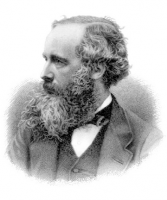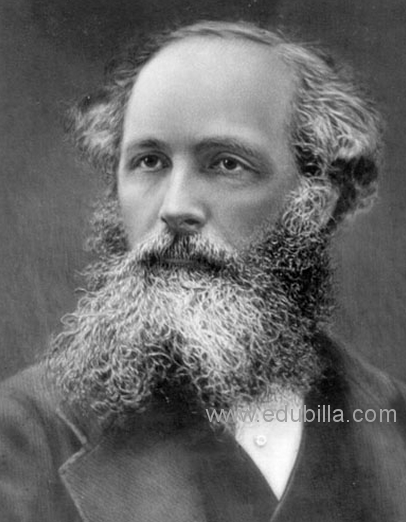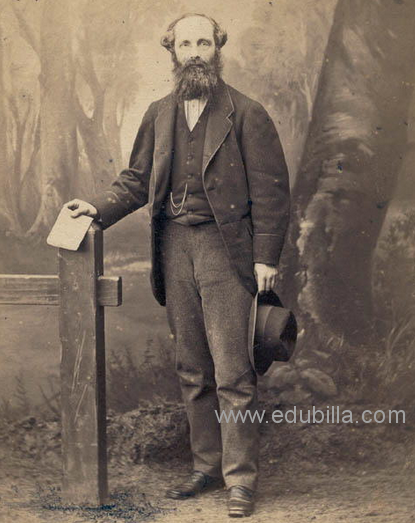










James Clerk Maxwell FRS FRSE was a Scottish mathematical physicist.His most notable achievement was to formulate the classical theory of electromagnetic radiation, bringing together for the first time electricity, magnetism, and light as manifestations of the same phenomenon. Maxwell's equations for electromagnetism have been called the "second great unification in physics"after the first one realised by Isaac Newton.
With the publication of A Dynamical Theory of the Electromagnetic Field in 1865, Maxwell demonstrated that electric and magnetic fields travel through space as waves moving at the speed of light. Maxwell proposed that light is an undulation in the same medium that is the cause of electric and magnetic phenomena.The unification of light and electrical phenomena led to the prediction of the existence of radio waves.
Maxwell helped develop the Maxwell–Boltzmann distribution, a statistical means of describing aspects of the kinetic theory of gases. He is also known for presenting the first durable colour photograph in 1861 and for his foundational work on analysing the rigidity of rod-and-joint frameworks (trusses) like those in many bridges.
His discoveries helped usher in the era of modern physics, laying the foundation for such fields as special relativity and quantum mechanics. Many physicists regard Maxwell as the 19th-century scientist having the greatest influence on 20th-century physics. His contributions to the science are considered by many to be of the same magnitude as those of Isaac Newton and Albert Einstein.In the millennium poll—a survey of the 100 most prominent physicists—Maxwell was voted the third greatest physicist of all time, behind only Newton and Einstein.On the centenary of Maxwell's birthday, Einstein described Maxwell's work as the "most profound and the most fruitful that physics has experienced since the time of Newton".
Early life, 1831–39
James Clerk Maxwell was born on 13 June 1831 at 14 India Street, Edinburgh, to John Clerk, an advocate, and Frances Cay.His father was a man of comfortable means of the Clerk family of Penicuik, holders of the baronetcy of Clerk of Penicuik. His father's brother was the 6th Baronet.He had been born "John Clerk", adding the surname Maxwell to his own after he inherited a country estate in Middlebie, Kirkcudbrightshire, from connections to the Maxwell family, themselves members of the peerage.James was the first cousin of the artist Jemima Blackburn.
Maxwell's parents did not meet and marry until they were well into their thirties; his mother was nearly 40 years old when he was born. They had had one earlier child, a daughter named Elizabeth, who died in infancy.
When Maxwell was young his family moved to Glenlair House, which his parents had built on the 1,500 acres (610 ha) Middlebie estate.All indications suggest that Maxwell had maintained an unquenchable curiosity from an early age.By the age of three, everything that moved, shone, or made a noise drew the question: "what's the go o' that?"In a passage added to a letter from his father to his sister-in-law Jane Cay in 1834, his mother described this innate sense of inquisitiveness:
He is a very happy man, and has improved much since the weather got moderate; he has great work with doors, locks, keys, etc., and "show me how it doos" is never out of his mouth. He also investigates the hidden course of streams and bell-wires, the way the water gets from the pond through the wall....
Education, 1839–47
Recognising the potential of the young boy, Maxwell's mother Frances took responsibility for James's early education, which in the Victorian era was largely the job of the woman of the house.At eight he could recite long passages of Milton and the whole of the 119th psalm (176 verses). Indeed his knowledge of scripture was already very detailed; he could give chapter and verse for almost any quotation from the psalms. His mother was taken ill with abdominal cancer and, after an unsuccessful operation, died in December 1839 when he was eight years old. James's education was then overseen by his father and his father's sister-in-law Jane, both of whom played pivotal roles in his life.His formal schooling began unsuccessfully under the guidance of a sixteen-year-old hired tutor. Little is known about the young man John hired to instruct his son, except that he treated the younger boy harshly, chiding him for being slow and wayward.John dismissed the tutor in November 1841 and, after considerable thought, sent James to the prestigious Edinburgh Academy.He lodged during term times at the house of his aunt Isabella. During this time his passion for drawing was encouraged by his older cousin Jemima.
The ten-year-old Maxwell, having been raised in isolation on his father's countryside estate, did not fit in well at school.The first year had been full, obliging him to join the second year with classmates a year his senior.His mannerisms and Galloway accent struck the other boys as rustic. Having arrived on his first day of school wearing a pair of homemade shoes and a tunic, he earned the unkind nickname of "Daftie".He never seemed to resent the epithet, bearing it without complaint for many years.Social isolation at the Academy ended when he met Lewis Campbell and Peter Guthrie Tait, two boys of a similar age who were to become notable scholars later in life. They remained lifelong friends.
Maxwell was fascinated by geometry at an early age, rediscovering the regular polyhedra before he received any formal instruction.Despite winning the school's scripture biography prize in his second year, his academic work remained unnoticed until, at the age of 13, he won the school's mathematical medal and first prize for both English and poetry.
Maxwell's interests ranged far beyond the school syllabus and he did not pay particular attention to examination performance.He wrote his first scientific paper at the age of 14. In it he described a mechanical means of drawing mathematical curves with a piece of twine, and the properties of ellipses, Cartesian ovals, and related curves with more than two foci. His work Oval Curves was presented to the Royal Society of Edinburgh by James Forbes, a professor of natural philosophy at Edinburgh University,but Maxwell was deemed too young to present the work himself.The work was not entirely original, since René Descartes had also examined the properties of such multifocal ellipses in the seventeenth century, but he had simplified their construction.
Later years, 1865–1879
In 1865 Maxwell resigned the chair at King's College, London, and returned to Glenlair with Katherine. In his paper On reciprocal figures, frames and diagrams of forces (1870) he discussed the rigidity of various designs of lattice.He wrote the textbook Theory of Heat (1871) and the treatise Matter and Motion (1876). Maxwell was also the first to make explicit use of dimensional analysis, in 1871.
In 1871 he became the first Cavendish Professor of Physics at Cambridge.Maxwell was put in charge of the development of the Cavendish Laboratory, supervising every step in the progress of the building and of the purchase of the collection of apparatus.One of Maxwell's last great contributions to science was the editing (with copious original notes) of the research of Henry Cavendish, from which it appeared that Cavendish researched, amongst other things, such questions as the density of the Earth and the composition of water.
Maxwell died in Cambridge of abdominal cancer on 5 November 1879 at the age of 48.His mother had died at the same age of the same type of cancer.The minister who regularly visited him in his last weeks was astonished at his lucidity and the immense power and scope of his memory, but comments more particularly,... his illness drew out the whole heart and soul and spirit of the man: his firm and undoubting faith in the Incarnation and all its results; in the full sufficiency of the Atonement; in the work of the Holy Spirit. He had gauged and fathomed all the schemes and systems of philosophy, and had found them utterly empty and unsatisfying — "unworkable" was his own word about them — and he turned with simple faith to the Gospel of the Saviour.
As death approached Maxwell told a Cambridge colleague
I have been thinking how very gently I have always been dealt with. I have never had a violent shove all my life. The only desire which I can have is like David to serve my own generation by the will of God, and then fall asleep.
Maxwell is buried at Parton Kirk, near Castle Douglas in Galloway close to where he grew up.The extended biography The Life of James Clerk Maxwell, by his former schoolfellow and lifelong friend Professor Lewis Campbell, was published in 1882.His collected works were issued in two volumes by the Cambridge University Press in 1890.
Smith's Prize (1854)
Adams Prize (1857)
Rumford Medal (1860)
Keith Prize (1869–71)

